Air Ambulance
Air Ambulance

Understanding Air Ambulance: An Air Ambulance is a specially designed aircraft equipped with advanced medical facilities and staffed by a highly trained medical team. Its primary purpose is to transport patients, often in critical condition, to medical facilities, regardless of geographical barriers. Air Ambulances can be fixed-wing aircraft or helicopters, with each type serving specific needs based on the patient’s condition and the distance to the destination.
Speed and Accessibility: Time is of the essence in medical emergencies, and Air Ambulances excel in delivering speed and accessibility. With the ability to fly at higher speeds and over challenging terrains, these aerial medical units can reach remote locations, accident sites, or rural areas in a fraction of the time it would take a ground ambulance. This swift response can significantly impact patient outcomes, particularly in cases where urgent medical intervention is required.
Specialized Medical Care: Air Ambulances are equipped with advanced medical equipment akin to those found in intensive care units (ICUs). These include cardiac monitors, ventilators, defibrillators, infusion pumps, and various life-saving medications. The medical team on board usually consists of paramedics, critical care nurses, and, in some cases, physicians, who are specially trained in aeromedical care. Their expertise allows for immediate medical attention and stabilization during the flight.
Versatility and Adaptability: Air Ambulances are versatile and can accommodate various patient needs. From critical care transports to neonatal transfers, they can be tailored to suit different medical conditions. Incubators for premature infants, neonatal intensive care equipment, and specialized medical beds are just some of the features that make Air Ambulances adaptable to diverse medical situations.
Inter-Hospital Transfers: Apart from emergency response, Air Ambulances also facilitate inter-hospital transfers for patients requiring higher levels of care or specialized treatments. When time is of the essence and ground transport is not feasible due to distance or patient condition, Air Ambulances efficiently bridge the gap, ensuring that patients reach the appropriate medical facility for their specific needs.
Coordination and Communication: Air Ambulance services work in close coordination with ground-based emergency medical services, hospitals, and emergency response centers. Prior to the flight, patient information is shared with the receiving medical facility, ensuring that the necessary preparations are made. Throughout the flight, continuous communication enables real-time updates on the patient’s condition, allowing the receiving facility to be ready for the patient’s arrival.
Global Reach: Air Ambulances are not bound by borders, making them an invaluable resource for international medical evacuations. They can rapidly transport patients from one country to another, ensuring they receive the best possible medical care, even if it involves crossing vast distances or international borders.
